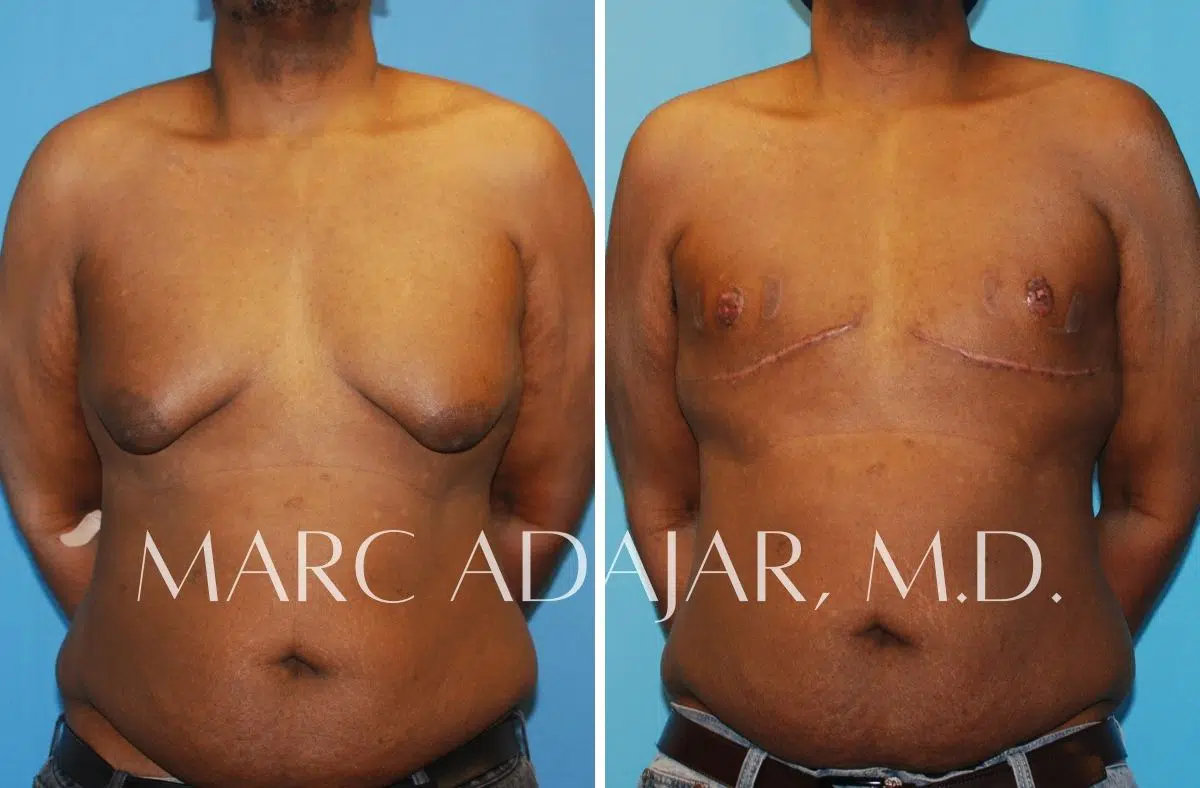MASTECTOMY SURGERY FOR MEN | CHICAGO, IL
Mastectomy For Severe Gynecomastia with ChestSculpt®
"Absolutely incredible and honestly life changing results from doctor adajar. He really knows his stuff. Expectations were met and exceeded. Would highly recommend seeking him out if you are suffering from gynocomastia."
A mastectomy is necessary to treat severe forms of gynecomastia. Type 4 gynecomastia is the most advanced form of gynecomastia. Type 4 gynecomastia occurs when part, or all, of the male breast hangs down below the skin crease underneath the breast (otherwise known as the inframammary fold). The treatment for type 4 gynecomastia is different from the milder forms because of the associated extra skin seen in this type. In order to obtain the goal of a flat, muscular looking chest, this excess skin has to be addressed alongside the breast gland and fat.
The goal of surgery in type 4 gynecomastia is to obtain a flat chest by removing the breast gland, breast fat, and the skin of the breast. Removing only the breast gland and fat without the skin will result in loose, floppy skin that hangs down from the chest onto the upper abdomen. Therefore, skin excision is necessary to prevent this.
The procedure itself begins with excising the breast gland, fat, and skin with an elliptical incision that starts at the middle of the chest and extends to the sides of the chest. The breast gland, fat, and skin is then removed off the underlying muscle. Several layers of dissolving sutures are used to bring together the skin around the area left by removing the breast. Sometimes drains are placed underneath the skin to remove any excessive buildup of fluid or blood that can affect the healing process after the surgery. These drains are small tubes that exit the skin underneath the armpit and collect fluid into bulbs that are connected to the end of the tubes. These bulbs are emptied daily. The drains are removed within 7 days after the procedure. The procedure of removing the entire breast is called a “mastectomy.”
Once the mastectomy is done on both sides, the nipples are placed back onto the newly formed flat chest from the breasts that were removed. The nipple is gently cut off from the old breast and sutured onto the new chest. The nipple is then covered with a protective dressing that stays in place for a couple of weeks as it heals onto the new chest. Once the protective dressings are removed after several weeks, the nipples have healed onto their new home. This portion of the procedure is called “nipple grafting.”
The formal name of this entire procedure is called a bilateral mastectomy with free nipple grafting. The term “male breast reduction surgery” is often used to describe this procedure, however any surgery that treats gynecomastia can be considered a male breast reduction surgery.

ChestSculpt® was exclusively designed to effectively treat gynecomastia. This male chest procedure is a minimally-invasive, 45 minute surgical procedure that will completely remove excess breast tissue in males, also referred to as “man boobs”, “moobs” or “male breasts”.
Unlike traditional male breast reduction surgery, which uses only liposuction or excision, our gynecomastia surgeons are experts in body sculpting procedures and utilize a 3-pronged approached in order to achieve the best results.
- A tumescent infusion is used to anesthetize and “wet” the fat and glandular tissues, this approach helps minimize any bleeding.
- This is followed by power-assisted liposuction using a MicroAire Liposculptor™ to safely and efficiently remove fat and sculpt the area around the gland.
- Finally, the gland is carefully excised and REMOVED COMPLETELY through a key-hole incision at the border of the nipple.
"...I'm super happy with the results only one month out from a chest sculpt procedure.."
"I’ve been researching this prosedure for a number of years now and have had intentions of going out of state to Austin texas and New York. I’m so glad I found Dr. Marc Adajar from Xscuplt! He and his staff have gone far beyond my expectations. Im super happy with the results only one month out from a chest sculpt procedure. The scars are unrecognizable! I didn’t need any pain medication what so ever right after surgery. On a personal level Dr. Marc is far more than a great artist when it comes to cosmetic surgery. He treats you like a friend. I’ve never in 46 years have had a dr. Take time out of his busy schedule to text me call me and give out his personal cell phone number. I would strongly recommend visiting xscuplt for any cosmetic related procedure that they offer. His staff has had also reached out to me many times post surgery. Thanks XSculpt and Thank you Marc!"
MASTECTOMY FREQUENTLY ASKED QUESTIONS
There could be many reasons males can develop gynecomastia (enlarged male breasts). Common causes can be attributed to:
- Certain medications or drugs
- Marijuana use
- Steroid use (SEE OUR BLOG “Bodybuilder Gynecomastia”)
- Certain supplements
- Obesity
- Hormone imbalance (estrogen)
- Genetic predisposition
While it is rare, male breast cancer can also cause gynecomastia. A qualified physician would be able to determine if this is the case prior to getting treated. Often times there is no clear medical cause.
A double male mastectomy is essentially a mastectomy that is done on both sides. For treatment of type 4 gynecomastia, a double mastectomy is almost always done. Examples, when a single male mastectomy would be done, would be for one-sided type 4 gynecomastia and for treatment for male breast cancer.
After surgery, a compression vest is worn for several weeks to limit swelling associated with surgery, protect the surgical area, and to keep pressure on the newly placed nipples. The drains (if used) are removed within 7 days. No exercise is recommended for the first several weeks to prevent any sutures from breaking and to allow the nipples to heal properly. After several weeks once the incisions and nipples have healed, the dressings on the nipples and incisions are removed. The compression vest can be stopped at this point and replaced with a compression shirt for a couple of weeks as extra support during the final phases of healing. After 6-8 weeks after surgery, exercise can be resumed. Restrictions are minimal after 2 months after surgery.
It can take several months to reach the final result as the skin, nipples, and incisions completely heal from the surgery. However, the improved appearance of the chest is immediately seen. Instead of prominent female-appearing breasts, the patient will have thin lines at the bottom of the chest underneath the pectoral muscles. The nipples will be smaller and sit on a flat surface. Tighter, form-fitting clothes can be proudly worn and self-confidence regained.
Scarring is your body's natural response after surgery. There will be a long incision where the breast used to be on the chest. Immediately after surgery, we recommend keeping your incision clean to help the healing process. This incision heals well over time and often results in a thin line. To help minimize the scar's appearance, the use of scar creams and silicone strips after surgery can be used.
Mastectomy For Men Gallery




